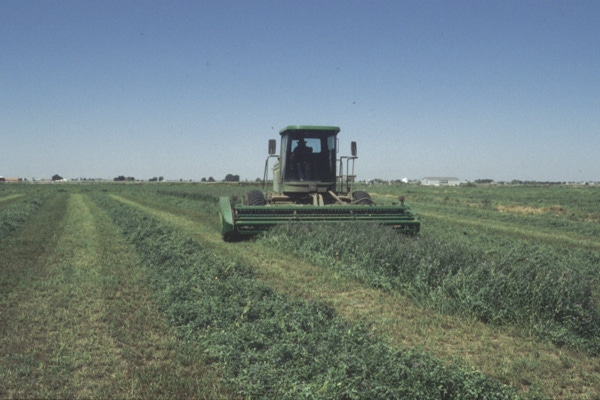March 8, 2011

Alfalfa is a crop with high nutrient removal rates, with average values of 10 to 12 pounds of phosphate (P2O5) and 60 pounds of potash (K2O) per ton of alfalfa. Annual fertilizer application of phosphorus and potassium is often needed to maintain good stand vigor and longevity of an alfalfa field, said Dorivar Ruiz Diaz, Kansas State University Research and Extension nutrient management specialist.
Alfalfa also responds to some secondary and micronutrients and in Kansas, sulfur and boron can often limit yield potential and should be monitored periodically, he said.
“First of all, for new seedings, it is important to build up soil test phosphorus and potassium to the optimum range before seeding, because this is the only opportunity (for the life of the stand) to mix the nutrients through the topsoil. At seeding, small amounts of phosphorus and potassium can be banded below the seed, making sure to allow adequate separation between the seed and the fertilizer band,” Ruiz Diaz said.
On established stands, dryland alfalfa can be topdressed with phosphorus or potassium fertilizers in either the fall, early spring, or even after the first cutting.
Irrigated stands can also be fertilized at those times or after any cutting because moisture can be supplied to make the topdressed fertilizer available to plants.
Phosphorus is a relatively immobile nutrient in the soil, but it can still be effective if it is broadcast on the soil surface in an established alfalfa stand, he said. “Broadcasting phosphorus has proven effective on soils low in phosphorus because alfalfa has roots near the soil surface,” he said.
Although phosphorus and potassium fertilizer can be beneficial to alfalfa if applied in the early spring or after the first cutting, if soil tests show the nutrients are needed, producers also should remember the importance of early fall applications, Ruiz Diaz added.
“For established stands, the critical time when alfalfa needs the most phosphorus and potassium is usually in preparation for winter. To boost the winter hardiness of the crop, a good supply of phosphorus and potassium needs to be added before the critical fall growth period. Early fall fertilization when there is still some plant growth (four to six weeks before dormancy) is usually more effective in increasing winter survival, because nutrients are supplied in time for adequate uptake,” he said.
When high nutrient application rates are needed to boost soil fertility, splitting the total required amount into two or more applications is recommended in order to avoid salt injury and luxury consumption beyond the alfalfa nutritional requirement.
Lime is also important for alfalfa, but should be applied before seeding and during land preparation for planting, Ruiz Diaz said. Alfalfa grows best in a soil pH range of 6.5 to 7.5 and when needed, lime should be applied to reach a pH of 6.8.
It is neither necessary nor desirable to apply nitrogen to established stands of alfalfa. “Nitrogen fertilizer applied to well-nodulated alfalfa will only stimulate grassy and broadleaf weeds, and may reduce stand longevity,” he said.
For more information, visit a local K-State Research and Extension office or see K-State publication C-683, Alfalfa Production Handbook, at: http://www.ksre.ksu.edu/library/crpsl2/c683.pdf.
You May Also Like




